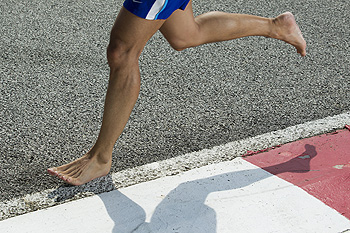Connect With Us
Blog
Items filtered by date: December 2020
How Diabetes Impacts the Feet
 The medical condition that is known as diabetes is considered to be a metabolic disorder. This is a disease that gradually develops as a result of elevated blood sugar levels, and generally falls into two categories. Type 1 diabetes is known to be an autoimmune disorder, and may appear in early childhood. Obesity may be a contributing factor in developing type 2 diabetes, and in many patients, occurs after the age of forty. High blood sugar levels may cause a loss of sensation in the feet, and it can become difficult to feel existing cuts and foot wounds. Diabetic patients may find it helpful to perform daily foot checks, and this can be beneficial to noticing any cuts or bruises that are present. If you have diabetes, it is strongly suggested that you are under the care of a podiatrist who can help you to manage this condition.
The medical condition that is known as diabetes is considered to be a metabolic disorder. This is a disease that gradually develops as a result of elevated blood sugar levels, and generally falls into two categories. Type 1 diabetes is known to be an autoimmune disorder, and may appear in early childhood. Obesity may be a contributing factor in developing type 2 diabetes, and in many patients, occurs after the age of forty. High blood sugar levels may cause a loss of sensation in the feet, and it can become difficult to feel existing cuts and foot wounds. Diabetic patients may find it helpful to perform daily foot checks, and this can be beneficial to noticing any cuts or bruises that are present. If you have diabetes, it is strongly suggested that you are under the care of a podiatrist who can help you to manage this condition.
Diabetic foot care is important in preventing foot ailments such as ulcers. If you are suffering from diabetes or have any other concerns about your feet, contact Chuc Dang, DPM from California . Our doctor can provide the care you need to keep you pain-free and on your feet.
Diabetic Foot Care
Diabetes affects millions of people every year. The condition can damage blood vessels in many parts of the body, especially the feet. Because of this, taking care of your feet is essential if you have diabetes, and having a podiatrist help monitor your foot health is highly recommended.
The Importance of Caring for Your Feet
- Routinely inspect your feet for bruises or sores.
- Wear socks that fit your feet comfortably.
- Wear comfortable shoes that provide adequate support.
Patients with diabetes should have their doctor monitor their blood levels, as blood sugar levels play such a huge role in diabetic care. Monitoring these levels on a regular basis is highly advised.
It is always best to inform your healthcare professional of any concerns you may have regarding your feet, especially for diabetic patients. Early treatment and routine foot examinations are keys to maintaining proper health, especially because severe complications can arise if proper treatment is not applied.
If you have any questions please feel free to contact our office located in Westminster, CA . We offer the newest diagnostic and treatment technologies for all your foot and ankle needs.
Common Reasons Why Bunions May Occur
 The joint that is affected by a bunion is located on the side of the big toe. A bunion appears as a large, bony protrusion, and it can occur for different reasons. These can consist of genetic factors, or from wearing shoes that do not have adequate room for the toes to move freely in. Common symptoms that are typically associated with bunions can include swelling, redness, and toe pain. Many patients notice that there are corns and calluses that form on top of the bunion. This can be a result of excess friction that is caused by shoes rubbing against the bunion. It is beneficial to wear larger shoes that can accommodate the bunion, as this may provide mild relief. If you notice an abnormal bump on your big toe, please consult with a podiatrist who can properly diagnose this ailment and offer you treatment options.
The joint that is affected by a bunion is located on the side of the big toe. A bunion appears as a large, bony protrusion, and it can occur for different reasons. These can consist of genetic factors, or from wearing shoes that do not have adequate room for the toes to move freely in. Common symptoms that are typically associated with bunions can include swelling, redness, and toe pain. Many patients notice that there are corns and calluses that form on top of the bunion. This can be a result of excess friction that is caused by shoes rubbing against the bunion. It is beneficial to wear larger shoes that can accommodate the bunion, as this may provide mild relief. If you notice an abnormal bump on your big toe, please consult with a podiatrist who can properly diagnose this ailment and offer you treatment options.
If you are suffering from bunion pain, contact Chuc Dang, DPM of California . Our doctor can provide the care you need to keep you pain-free and on your feet.
What Is a Bunion?
Bunions are painful bony bumps that usually develop on the inside of the foot at the joint of the big toe. As the deformity increases over time, it may become painful to walk and wear shoes. Women are more likely to exacerbate existing bunions since they often wear tight, narrow shoes that shift their toes together. Bunion pain can be relieved by wearing wider shoes with enough room for the toes.
Causes
- Genetics – some people inherit feet that are more prone to bunion development
- Inflammatory Conditions - rheumatoid arthritis and polio may cause bunion development
Symptoms
- Redness and inflammation
- Pain and tenderness
- Callus or corns on the bump
- Restricted motion in the big toe
In order to diagnose your bunion, your podiatrist may ask about your medical history, symptoms, and general health. Your doctor might also order an x-ray to take a closer look at your feet. Nonsurgical treatment options include orthotics, padding, icing, changes in footwear, and medication. If nonsurgical treatments don’t alleviate your bunion pain, surgery may be necessary.
If you have any questions, please feel free to contact our office located in Westminster, CA . We offer the newest diagnostic and treatment technologies for all your foot care needs.
Can Running Injuries Be Prevented?
 Some running injuries may be prevented by practicing proper training methods. The feet are often affected by running injuries, and unfortunately this can make it quite difficult to accomplish daily activities. It is important to strengthen the body, and this may help to gradually increase the mileage and intensity of your runs. It is beneficial to build strength in the legs separately, helping to decrease injury risk. Reverse lunges are known to improve stability, in addition to strengthening the lower part of the body. Flexibility in the hips and glutes may be increased when single leg deadlifts are frequently performed, and may become more challenging when a weight is held. If you would like additional information about how to prevent running injuries, please speak with a podiatrist.
Some running injuries may be prevented by practicing proper training methods. The feet are often affected by running injuries, and unfortunately this can make it quite difficult to accomplish daily activities. It is important to strengthen the body, and this may help to gradually increase the mileage and intensity of your runs. It is beneficial to build strength in the legs separately, helping to decrease injury risk. Reverse lunges are known to improve stability, in addition to strengthening the lower part of the body. Flexibility in the hips and glutes may be increased when single leg deadlifts are frequently performed, and may become more challenging when a weight is held. If you would like additional information about how to prevent running injuries, please speak with a podiatrist.
Exercising your feet regularly with the proper foot wear is a great way to prevent injuries. If you have any concerns about your feet, contact Chuc Dang, DPM of California . Our doctor will treat your foot and ankle needs.
How to Prevent Running Injuries
Many common running injuries are caused by overuse and overtraining. When the back of the kneecap starts wearing out and starts causing pain in your knee, this is commonly referred to as runner’s knee. Runner’s knee is a decrease in strength in your quadriceps and can occur if you’re not wearing properly fitted or supporting shoes. To prevent runner’s knee, focusing on hip strengthening is a good idea, as well as strengthening your quads to keep the kneecaps aligned.
What Are Some Causes of Running Injuries?
- One cause of a common running injury is called iliotibial band syndrome.
- Plantar fasciitis is also another common injury.
- Stress fractures can occur from overtraining, lack of calcium, or even your running style.
Best Ways to Prevent Running Injuries
- Wear footwear that fits properly and suits your running needs.
- Running shoes are the only protective gear that runners have to safeguard them from injury.
- Make a training schedule. Adding strengthening exercises as well as regular stretching can help keep you strong and limber and can lessen the possibility of injuries.
- Stretching keeps muscles limber; this will help you gain better flexibility.
If you have any questions please feel free to contact our office located in Westminster, CA . We offer the newest diagnostic and treatment technologies for all your foot and ankle needs.